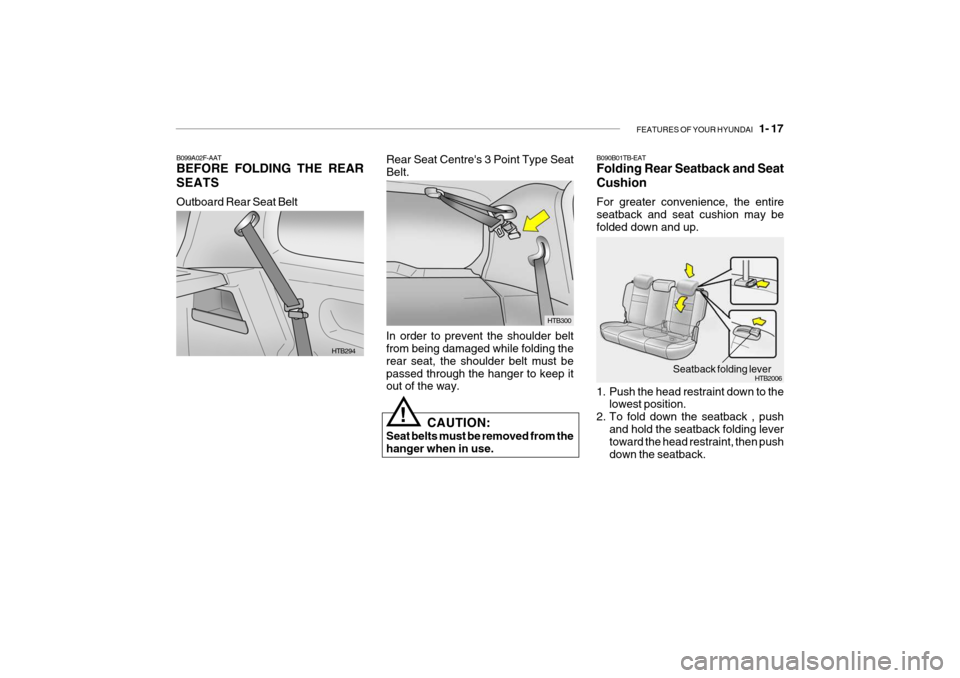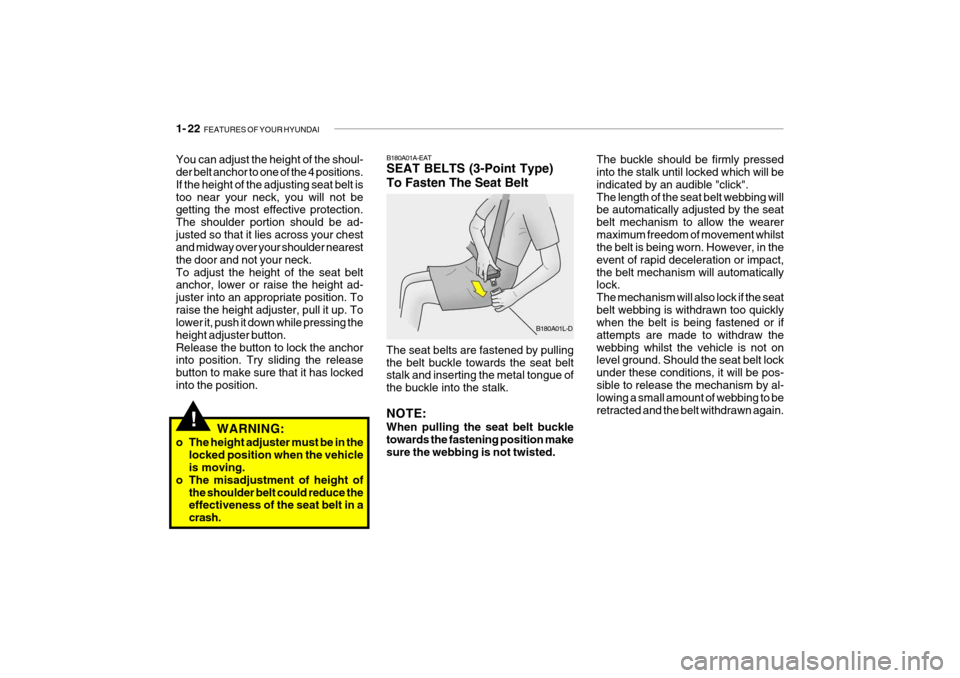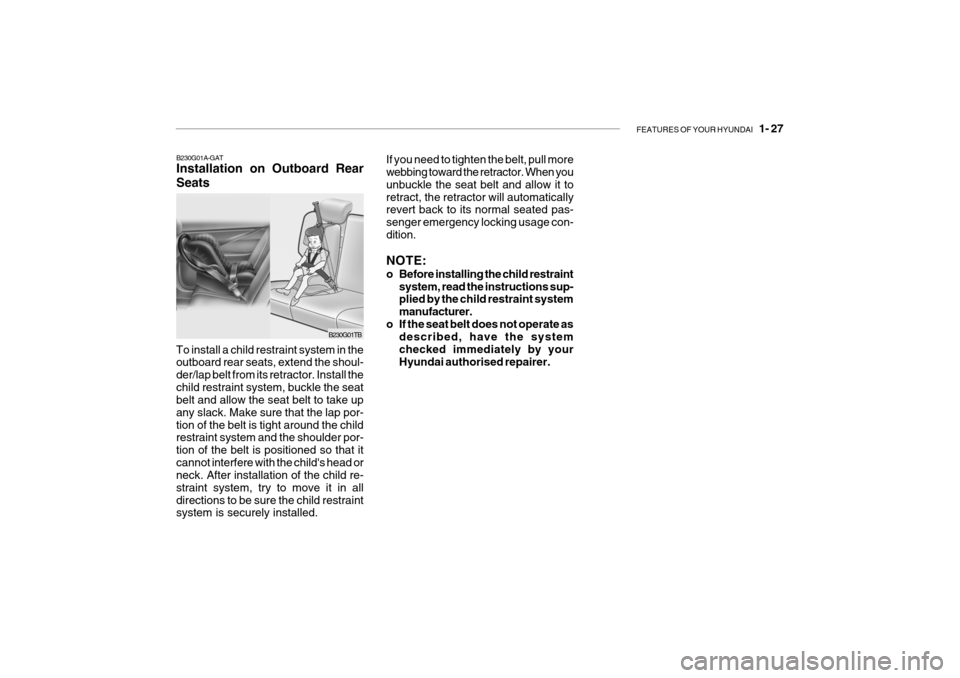2007 Hyundai Getz tow
[x] Cancel search: towPage 244 of 463

8- 6 CONSUMER INFORMATION
I100A01TB-GAT SPARE TIRE AND TOOLS
Your Hyundai is delivered with the fol- lowing: Spare tire and wheel Wheel nut wrench, Wrench bar, Screw driver,Jack, Towing hook HTB224
WARNING:
o Driving on worn-out tires is dan- gerous! Worn-out tires can cause
loss of braking effectiveness, steering control and traction. When replacing tires, never mixradial and bias-ply tires on the same car. If you replace radial tires with bias-ply tires, they mustbe installed in sets of four.
o Using tires and wheels of other
than the recommended sizes maycause unusual handling charac- teristics that may cause death, serious injury or property dam-age.
o Tires degrade over time, even when
they are not being used. Regard-less of the remaining tread, it is recommended that tires generally be replaced after six (6) years ofnormal service. Heat caused by hot climates or frequent high load- ing conditions can accelerate theaging process. Failure to follow this warning can result in sudden tire failure, which could lead to aloss of control and an accident involving serious injury or death.
!
The original tires on your car have tread wear indicators. The tread wear indica- tors appear when the tread depth is 1.6 mm (0.06 in.). The tire should be re-placed when these appear as a solid bar across two or more grooves of the tread. Always replace your tires withthose of the recommended size. If you change wheels, the new wheel's rim width and offset must meet Hyundaispecification.
I090A02S-GAT WHEN TO REPLACE TIRES
Wear indicator
1.6 mm (0.06 in.)
HGK248
Page 254 of 463

10- 6 INDEX
Towing
A trailer (or vehicle) ................................................. 2-19
Emergency .............................................................. 3-13
If your vehicle must be towed ................................. 3-11
Trailer or Vehicl e towing ............................................. 2-19
Transaxle
Automa tic ................................................................. 2-9
Automatic transaxle fluid checking .......................... 6-15
Manual ...................................................................... 2-7
Manual transaxle Oil checking ................................ 6-14
Trip Computer ............................................................. 1-57
Trip Odometer ............................................................. 1-56
Turn signal operation .................................................. 1-59
V Vehicle Identifi cation Number ...................................... 8-2
Ventilation ................................................................... 1-86
Ventilator
Center ventilator ...................................................... 1-86
Side ventilator .......................................................... 1-87
W Warning Lights ............................................................ 1-48
Window glass ............................................................. 1-12
Windshield washer operation ......................................1-62
Windshield Wiper and Washer sw itch .........................1-61
Windshield Wiper Blades ............................................ 6-12
Winter Driving ............................................................. 2-16
Page 270 of 463

1- 4 FEATURES OF YOUR HYUNDAI
5) Avoid rapid acceleration and maxi-
mum throttle openings.
6) Avoid harsh braking during the first 100 miles of urban motoring or 1,000 miles of motorway driving to allow the friction facings of the brake padsand shoes to bed against the discs and drums properly.
7) No trailer towing should be under- taken during the running-in period.
B020B01FC-EAT (Diesel Engine) The longevity and performance of the vehicle are greatly affected by the care exercised during the first 1,000 miles ofmotoring. Because of modern manu- facturing techniques, rigid guidelines regarding maximum road speeds havebecome unnecessary. However, cer- tain precautions should be observed in order to obtain the best possible perfor-mance and useful life from the vehicle.
YB020A1-E BEFORE ENTERING THE VEHICLE
o Ensure that all windows, mirrors and
lamps are clean.
o Check condition of all tyres.
o Ensure that no fluid leaks are evi- dent.
o Ensure that the area around the ve- hicle is clear before driving off.
YB020B1-E AFTER ENTERING THE VEHICLE
o Ensure that all occupants fasten and correctly adjust seat belts.
o Ensure that seat and head restraint positions are adjusted for optimum safety, control and comfort.
o Adjust interior and exterior rear view mirrors.
o Verify correct operation of lamps,
horn and other electrical equipment.
o Ensure that warning lamps illumi- nate when ignition is turned on.
NOTE: Fluid levels such as engine oil, en- gine coolant, brake and windscreen washer fluid should be checked dailyor at each refuelling, whichever oc- curs sooner. B020A01FC-EAT RUNNING IN YOUR NEW HYUNDAI (Petrol Engine) The longevity and performance of the vehicle are greatly affected by the care exercised during the first 1,000 miles ofmotoring. Because of modern manu- facturing techniques, rigid guidelines regarding maximum road speeds havebecome unnecessary. However, cer- tain precautions should be observed in order to obtain the best possible perfor-mance and useful life from the vehicle.
1) Do not race the engine without a load
(i.e revving the engine in neutral).
2) During the first 500 miles the maxi-
mum engine speed should be re- stricted to 3,000 rpm and gradually increased thereafter.
3) Avoid prolonged constant speed op- eration. The internal components ofthe engine will become more quickly run in if the operation speed is variedduring the running-in period.
4) Never allow the engine to labour. Use
the gearbox freely and avoid largethrottle openings when the engine speed is below 1,500 rpm.
Page 271 of 463

FEATURES OF YOUR HYUNDAI 1- 5
B880A01A-EAT IMMOBILISER SYSTEM The immobiliser system is an anti-theft device, designed to deter vehicle theft.
B885B02O-EAT Keys
1) Do not race the engine without a load
(i.e revving the engine in neutral).
2) During the first 600 miles the maxi- mum engine speed should be re- stricted to 3,000 rpm and gradually increased thereafter. And while driv-ing, keep under three quarters of maximum vehicle speed.
3) Avoid prolonged constant speed op- eration. The internal components ofthe engine will become more quickly run in if the operation speed is variedduring the running in period.
4) Never allow the engine to labour. Use
the gearbox freely and avoid largethrottle openings when the engine speed is below 1,500 rpm.
5) Avoid rapid acceleration and maxi- mum throttle openings.
6) Avoid harsh braking during the first
100 miles of urban motoring or 1,000 miles of motorway driving to allow the friction facings of the brake pads and shoes to bed against the discsand drums properly.
7) No trailer towing should be under
taken during the running in period. All of the locks fitted to the vehicle areoperated by the same key. However,since it is possible to lock the doors without the use of the key, care should be exercised to ensure that the keydoes not become locked inside the vehicle by mistake.
AX10020A-1NOTE: A non-genuine duplicate key will not start the engine.
!
CAUTION:
o When starting the engine, do not use the key with other immobiliser keys around. Otherwise the en- gine may not start or may stop soon after it starts.Keep each keys separately not to have any malfunction after you receive your new vehicle.
o Do not put metal accessories near the key or ignition switch.The engine may not start for themetal accessories may interrupt the transponder signal from nor- mally transmitting.
Page 274 of 463

1- 8 FEATURES OF YOUR HYUNDAI
B070A01A-EAT ANTI-THEFT ALARM SYSTEM (Not all models) This system is designed to provide protection from unauthorized entry intothe car. This system is operated in three stages: the first is the "Armed" stage, the second is the "Alarm" stage,and the third is the "Disarmed" stage. If triggered, the system provides an au- dible alarm with blinking of the turnsignal lights. Park the car and stop the engine. Arm the system as described below.
1) Remove the ignition key from the
ignition switch.
2) Make sure that the engine bonnet ,
doors and hatchback door are closed.
3) Lock the doors using the transmitter
of the keyless entry system.
After completion of the steps above, the turn signal lights will blink once toindicate that the system is armed.
B070B01TB-D
B070B01O-EAT Armed Stage
o When the door is unlocked, the
red mark on the switch is visible and the character "LOCK" on theswitch is visible.
o The central door locking is oper-
ated by turning the key (with theft-alarm system: driver's door and passenger's door, without theft- alarm system: driver's door only)toward the front or rear of the vehicle.
o If the door is locked/unlocked mul- tiple times in rapid successionwith either the vehicle key or door lock switch, the system may stopoperating temporarily in order to protect the circuit and prevent damage to system components.
SB040G2-E CENTRAL DOOR LOCKING (Not all models)
HTB212-D
The central door locking is operated by pushing the driver's door lock switch toward the front or rear of the vehicle. Ifthe passenger and rear doors are open when the switch is pushed, the door will remain locked when closed. NOTE:
o When pushing the switch toward the rear, all doors and tail gate will unlock.When pushing the switch toward the front, all doors and tail gate will lock.
Page 283 of 463

FEATURES OF YOUR HYUNDAI 1- 17
HTB294
B099A02F-AAT BEFORE FOLDING THE REAR SEATS Outboard Rear Seat Belt
HTB300
!
Rear Seat Centre's 3 Point Type Seat Belt.
In order to prevent the shoulder beltfrom being damaged while folding the rear seat, the shoulder belt must bepassed through the hanger to keep it out of the way. CAUTION:
Seat belts must be removed from the hanger when in use.
B090B01TB-EAT Folding Rear Seatback and Seat Cushion For greater convenience, the entire seatback and seat cushion may be folded down and up.
1. Push the head restraint down to the lowest position.
2. To fold down the seatback , push and hold the seatback folding lever toward the head restraint, then push down the seatback. HTB2006
Seatback folding lever
Page 288 of 463

1- 22 FEATURES OF YOUR HYUNDAI
The buckle should be firmly pressed into the stalk until locked which will be indicated by an audible "click".The length of the seat belt webbing will be automatically adjusted by the seat belt mechanism to allow the wearermaximum freedom of movement whilst the belt is being worn. However, in the event of rapid deceleration or impact,the belt mechanism will automatically lock. The mechanism will also lock if the seatbelt webbing is withdrawn too quickly when the belt is being fastened or if attempts are made to withdraw thewebbing whilst the vehicle is not on level ground. Should the seat belt lock under these conditions, it will be pos-sible to release the mechanism by al- lowing a small amount of webbing to be retracted and the belt withdrawn again.
B180A01A-EAT SEAT BELTS (3-Point Type) To Fasten The Seat Belt
B180A01L-D
The seat belts are fastened by pulling the belt buckle towards the seat belt stalk and inserting the metal tongue of the buckle into the stalk. NOTE: When pulling the seat belt buckle towards the fastening position makesure the webbing is not twisted.
!
You can adjust the height of the shoul- der belt anchor to one of the 4 positions. If the height of the adjusting seat belt istoo near your neck, you will not be getting the most effective protection. The shoulder portion should be ad-justed so that it lies across your chest and midway over your shoulder nearest the door and not your neck.To adjust the height of the seat belt anchor, lower or raise the height ad- juster into an appropriate position. Toraise the height adjuster, pull it up. To lower it, push it down while pressing the height adjuster button.Release the button to lock the anchor into position. Try sliding the release button to make sure that it has lockedinto the position.
WARNING:
o The height adjuster must be in the locked position when the vehicle is moving.
o The misadjustment of height of the shoulder belt could reduce theeffectiveness of the seat belt in a crash.
Page 293 of 463

FEATURES OF YOUR HYUNDAI 1- 27
If you need to tighten the belt, pull more webbing toward the retractor. When you unbuckle the seat belt and allow it toretract, the retractor will automatically revert back to its normal seated pas- senger emergency locking usage con-dition. NOTE:
o Before installing the child restraint
system, read the instructions sup- plied by the child restraint system manufacturer.
o If the seat belt does not operate as described, have the systemchecked immediately by yourHyundai authorised repairer.
To install a child restraint system in the outboard rear seats, extend the shoul- der/lap belt from its retractor. Install thechild restraint system, buckle the seat belt and allow the seat belt to take up any slack. Make sure that the lap por-tion of the belt is tight around the child restraint system and the shoulder por- tion of the belt is positioned so that itcannot interfere with the child's head or neck. After installation of the child re- straint system, try to move it in alldirections to be sure the child restraint system is securely installed.B230G01A-GAT Installation on Outboard Rear Seats
B230G01TB